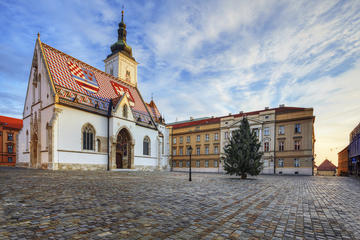 Lower Town (downtown) occupies the area between Ilica and the railway line, creating the modern center of Zagreb. Its disadvantages are primarily heavy buildings and bothersome noise, Fortunately, you mainly visit a series of parks with large Art Nouveau or Classicist palaces, museums, galleries and theaters. Parks surround the very center on three sides, taking more or less the shape of a horseshoe.
Lower Town (downtown) occupies the area between Ilica and the railway line, creating the modern center of Zagreb. Its disadvantages are primarily heavy buildings and bothersome noise, Fortunately, you mainly visit a series of parks with large Art Nouveau or Classicist palaces, museums, galleries and theaters. Parks surround the very center on three sides, taking more or less the shape of a horseshoe.
From Trgu Marsala Tita to the train station
The western part of the park and palace avenue begins at Marśala Tita Trog, which you can reach from Trgu ban Jelaćić via ul. Gayev, Teslina and Masarykova or take trams #12, 13, 14 i 17. Perhaps the most impressive edifice of Zagreb rises here – neo-baroque-classicist National Theater (1895), designed by a famous pair of Viennese architects – Fellnera in Helmera, somewhat reminiscent of Krakow's Teatr im. J. Słowacki. The Fountain of Life was situated in front of the building, the work of Meśtrovic (1905), and on the other side of the street another sculpture by this artist – Mother.
Near the theater, behind the Savska cesta there is another yellow palace, and in it – Arts and Crafts Museum (Museum of Arts and Crafts; Marshal Tito Square 10, tel.01/4826922, muo @ muo. hr; wt.-pt. 10.00—17.00, sb. i nd. 10.00-13.00), in which works of art are gathered, also usable, from gothic to modern times. The building was built in 1882-1892.
Further south begins Trg take Mazuranićev, and between him and the Savska cesta, in a commercial building with 1903 r., houses the Ethnographic Museum (Ethnographic Museum; Mażuranić Square 14, tel.01/4826220, emz@etnografski-muzej.hr; Tue-Thu. 10.00-18.00, pt.-nd. 10.00-13.00). The collections include everyday items, machinery, weapon – everything from different regions of Croatia and the world. The most exotic part of the exhibition is the work of Croatian travelers, braci Seljan. The collection consists of 80 thousand. items, of which less than two have been made available to visitors 3 thousand. It is one of the most interesting museums in Zagreb.
From the Ethnographic Museum it is enough to go through Savska cesta and Rooseveltov trg, to be near the famous Mimara Museum (Mimara Museum; Rooseveltov trg 5, tel.01/ 4828100, info@mimara.hr; wt., Wed., pt. i sb. 10.00-17.00, thurs. 10.00-19.00, nd. 10.00-14.00) in the huge neo-renaissance building of the former school of 1883 r. Exhibition, the work of the collector A.T. Mimary (1898-1987), it opened shortly after his death. Covers over 3750 exhibits, starting from ancient times (Egypt, Mesopotamia, Rome, China), and ending with the contemporaries. The collection of paintings is valuable, m.in. Rafaela, Rubens, Velazqueza, Rembrandt, Lever, Renoira and van Dycka.
The Marulićev Trg with the building of the National Library is an extension of the Trgu take Mażuranićev. Behind the library there is a botanical garden (Botanical Garden; Marulić Square 9a, tel.01/4844002; IV-X wt.-nd. 9.00-19.00), founded in 1890 r. It grows approx. 1800 species of exotic vegetation and several times more species of local flora.
Another curiosity in this part of the city is the impressive Technical Museum (Technical Museum; Sava road 18, two tram stops behind the Trgiem Marsala Tito, tel.01/4844050, tehnicki-muzej@tehnicki-muzej.hi-net.hr; wt.-pt. 9.00-17.00, sb. i nd. 9.00-13.00), created in 1954 r. There are, among others. exhibits related to astronomy (satellite models, spacecraft) i planetarium.
From the botanical garden, ul. Mihanovićeva brings you to the historic railway station.
From the train station to Trgu N. Śubića Zrinjski
Just north of the train station is Trg kralja Tomislav with the statue of the king. Behind it there is a yellow Art Nouveau building of the exhibition pavilion (Um-jetnik pavilion; King Tomislav Square 22, tel.01/4841070, info@umjet-nicki-paviljon.hr; pn.-sb. 11.00-17.00, nd. 10.00-13.00), which was erected in 1897 r. intended for the organization of large exhibitions (are held there to this day).
Further, for st. Strossmayer Square and Nikola Śubić Zrinjski Square are currently closed.. With the latter, the Strossmayer Gallery is located on the first floor of a 19th-century house (Strossmayer Gallery; Nikola Śubić Zrinjski Square 11, tel.01/4895117, sgallery@hazu.hr; wt. 10.00-13.00 i 17.00-19.00, -r.-nd. 10.00-13.00). Among the valuable exhibits, the most noteworthy is the famous Baścanska ploća - a plate written in Glagolitic, the oldest monument of Croatian literature, found on the island of Krk. The core of the collection is the collection of the 19th-century bishop Strossmayer. Among the paintings, the works of Jan Matejko and Henryk Siemiradzki are a nice accent. In the square in front of the building there is a sculpture of the bishop by Meśtrović.
On the other side of ul. Praska is the Gallery of Contemporary Art (Modern gallery; the. Coat of arms 1, tel.01/ 4922368, moderna-galerija@zg.hinet.hr; wt.—sb. 10.00-18.00, nd. 10.00- 13.00) with works by Croatian painters, sculptors, graphic designers etc., mainly from the years 1850-1950.
Another interesting object in the area is founded in 1846 r. Archeological museum (Archaeological Museum; Trg N.Ś. Zrinjski 19, tel.01/4873101, amz@amz.hr; wt.—pt. 10.00-17.00, sb. i nd. 10.00-13.00; 20/10 kn), presenting items from the most ancient history, m.in. remains of Roman buildings, Greek vases and Egyptian mummies. A treat for numismatists will be the largest collection of coins in Europe (ok. 260 thousand. pieces).
Coming back to ul. Coat of arms, and then going left along ul. Boskovic and Drislav, you reach Trgu Zrtava Faśizma with the characteristic oval building of the Croatian Art Center (HDLU, Home of Croatian Fine Artists; Victims of Fascism Square, 001/4611818, hdlu-zg@zg.tel.hr; wt.-pt. 11.00-19.00, sb. ind. 10.00-14.00), The structure, surrounded by concrete columns, is reminiscent of representative buildings in the United States. It was designed by Meśtrović (even though he was mainly a sculptor). In the past, she performed, among others. mosque function, Currently, temporary exhibitions are held in its halls.